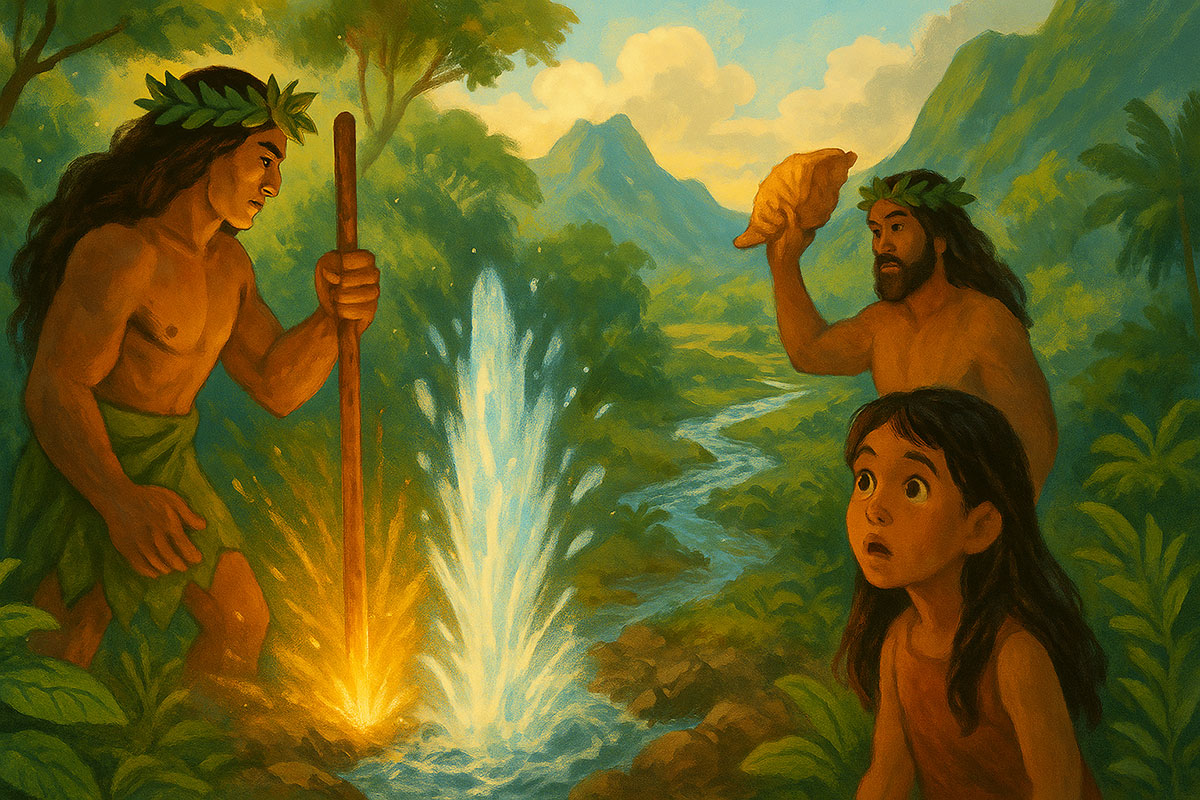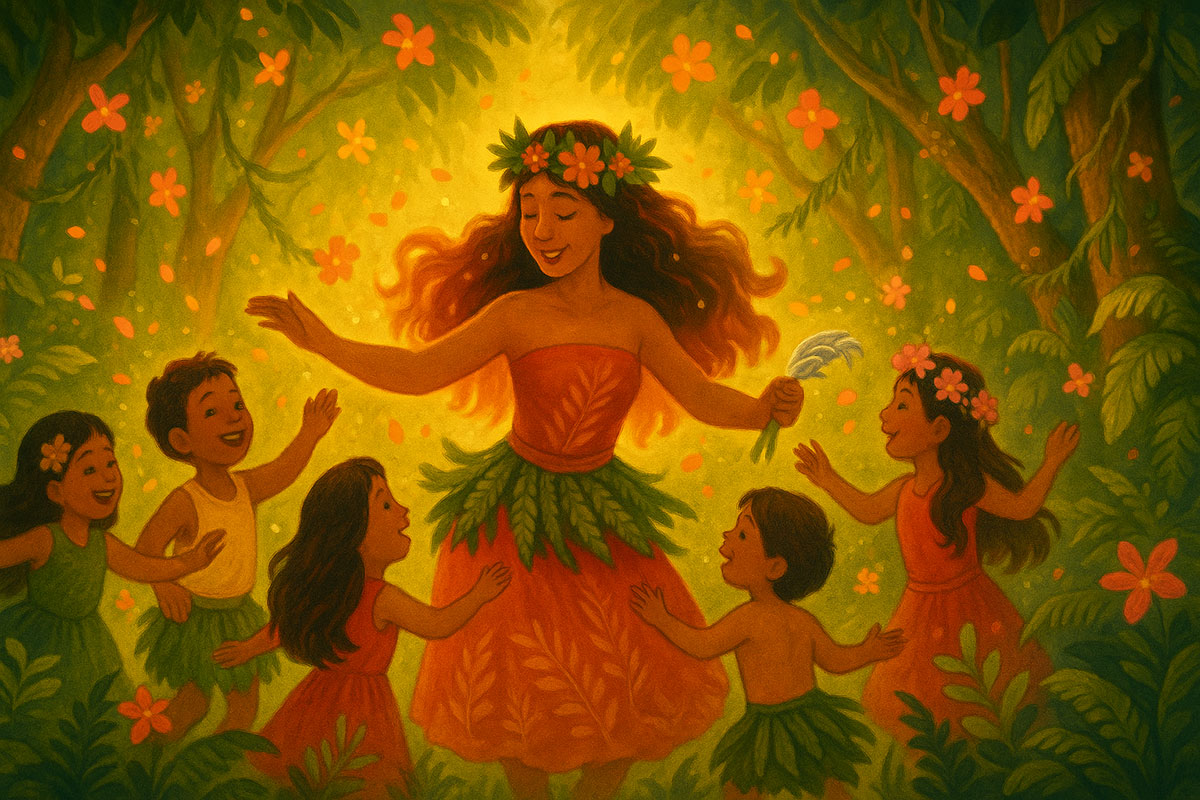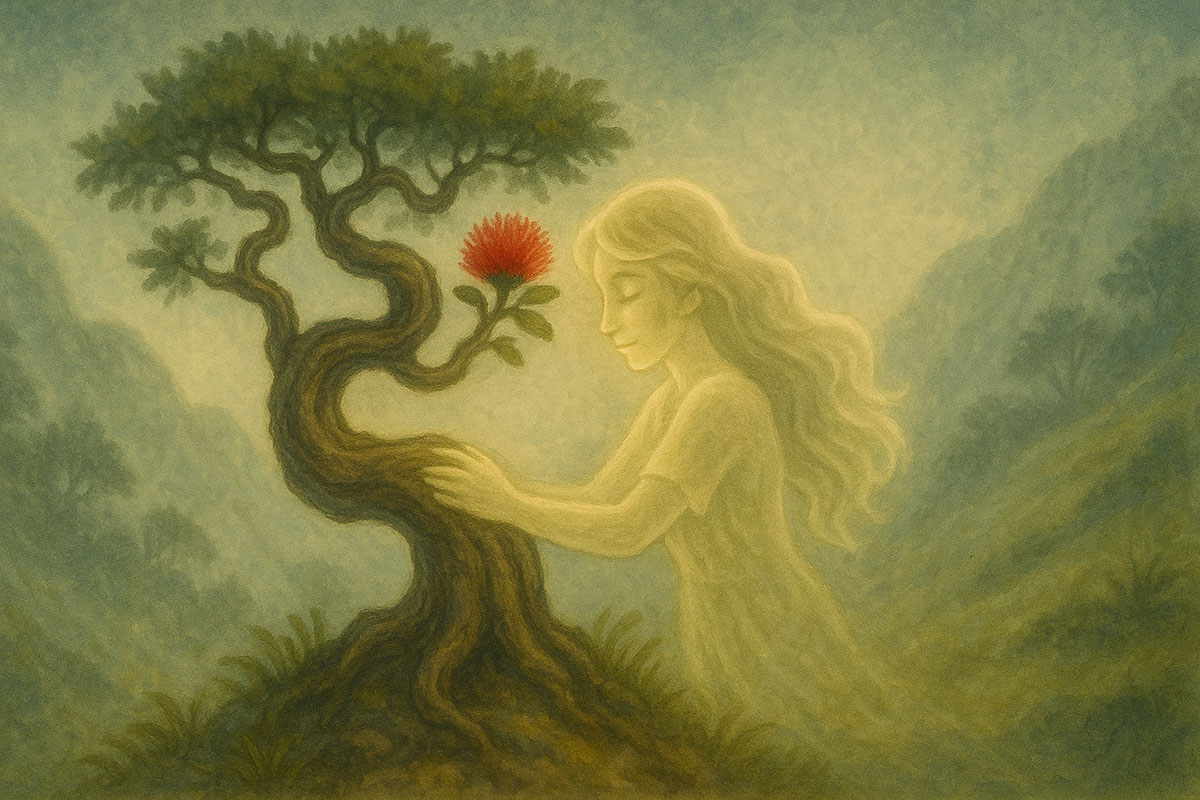
|
Getting your Trinity Audio player ready...
|

Kealiʻi Reichel
Aloha mai kākou,
Come, children of the islands—and those who dream of them.
Sit close, under the open sky. Can you feel the wind on your cheek? That’s the breath of the gods. Can you hear the rustle of the ti leaves? That’s the forest listening. Long before buildings and roads, long before clocks and screens, there were stories. Not just any stories—moʻolelo, passed from heart to heart, from lips to ears, across generations.
In these sacred tales, mountains speak. Trees love. Fire dances. Snow listens. These are not just old stories; they are living truths—lessons braided with aloha, rooted in our land, and blossoming in our imagination.
Today, I invite you to listen with your naʻau—your inner knowing. Let us walk together into the breath of these islands, where fire meets snow, rope holds the sun, and love grows from the earth as a single red flower.
These are the Legends of Aloha.
May they warm your spirit.
May they guide your steps.
And may they remind you:
You are part of the story too.
(Note: This is an imaginary conversation, a creative exploration of an idea, and not a real speech or event.)

Pele and Poliahu — The Fire and Ice Sisters

High above the sparkling sea, the mighty mountain Mauna Kea touched the clouds. Its snowy cap glittered under the sun like a crown of stars.
On that snowy mountain lived Poliahu, the gentle goddess of snow. Her long white hair flowed like icy waterfalls, and wherever she stepped, frost flowers bloomed.
One day, while Poliahu played with her snowmaidens, racing sleds down glittering slopes, a warm wind began to rise from the south.
“Hmm…” she said, brushing snowflakes from her cheeks. “That doesn’t feel right.”
Far below, in the fiery heart of another mountain—Kīlauea—lived Pele, the powerful goddess of volcanoes. Her eyes glowed like lava, and her laughter rolled like thunder.
“I want to race down your mountain,” Pele said, rising from her molten home. “Let’s see who’s truly stronger—fire or ice!”
Pele disguised herself as a traveler, her flames tucked deep inside her. She climbed Mauna Kea, where snow kissed her bare feet. Poliahu saw her approaching.
“Welcome, traveler,” Poliahu said with a smile. “Would you like to race sleds with us?”
Pele grinned. “I’d love to.”
The snowmaidens giggled as they handed her a polished koa wood sled. “Slide fast, stranger!” they said.
And oh, did she race! Pele flew down the slope, leaving a trail of steam behind. But Poliahu was faster—she glided like moonlight over the snow.
Pele burned with more than just fire. She was jealous.
As the race ended, Poliahu laughed gently. “You’re strong, friend. But today, the snow wins.”
Pele’s eyes flared red. “Then let me show you my real strength!”
With a roar, she cast off her disguise. Flames danced around her, melting the snow in great rivers. Lava burst from the ground, hissing and crackling.
Poliahu gasped. “You tricked us!”
Pele raised her arms. “Now my fire will rule this mountain!”
But Poliahu stood tall. Her breath turned to mist. She whispered to the clouds, and snow fell in thick, swirling blankets.
Lava met ice. The ground sizzled and steamed. Trees wept. Birds flew in circles, calling out in fear.
But Poliahu never wavered.
She raised her hands. “Enough!”
The snowstorm grew fierce. The lava cooled. Pele’s fire sputtered, trapped under blankets of frost.
Breathing hard, Pele stepped back.
Poliahu helped her up. “There is power in both of us. Fire creates… and destroys. Snow freezes… but protects. Let us not be enemies.”
Pele blinked. Then slowly, she smiled. “Maybe you’re right, sister.”
And from that day on, Mauna Kea remained crowned with snow, while Kīlauea burned brightly below. Fire and ice. Sisters from different skies.
Maui and the Sun — The Day the Sky Stood Still

Long ago, when the world was young, the days in Hawaiʻi were far too short.
The people would say, “Oh no! The sun is racing again!”
They hurried to plant taro, dry kapa cloth, and fish before the light slipped away.
High in the hills lived a clever demigod named Maui, with wild hair, strong arms, and a smile full of mischief.
One day, his mother, Hina, stood beside a river, holding her kapa cloth.
“Maui,” she sighed, “the sun dries it too fast. Before I can stretch it, the day is gone.”
Maui scratched his chin. “This won’t do. That sun’s too quick for its own good!”
He climbed the tallest mountain in the east—Haleakalā, the House of the Sun.
With a mighty rope made of his sister’s hair and mountain vines, Maui waited.
He waited through the night. He waited while stars blinked. He waited as birds began to sing.
Then—
WHOOSH!
The sun leapt from the sea, streaking across the sky!
Maui sprang up. “Got you now!”
He lassoed the sun with his rope. The sun thrashed, sending sparks flying.
“Who dares slow me down?” the sun bellowed.
“It is I, Maui!” he shouted. “You rush across the sky like a fish in a river! People don’t have time to live!”
The sun squirmed. “I rise and set as I please! Let me go!”
But Maui held tight. “Not until we make a deal.”
The sun grumbled. Clouds gathered. Lightning danced in the sky.
“Fine,” it hissed. “I’ll move slowly in summer, but I’ll still rush in winter. That is my offer.”
Maui thought. Then nodded. “Deal.”
And he let go.
The sun groaned, then rose slowly, stretching its golden arms across the sky.
From that day on, summer days became long and warm, and winter days short and cool. The people rejoiced!
“Look!” Hina smiled, holding up her kapa. “Plenty of time to dry!”
Maui chuckled. “Sometimes, even the sun needs to be reminded to slow down.”
And atop Haleakalā, if you wake early enough, you can still see the sun rising slowly—remembering the day Maui made time itself wait.
Kāne and Kanaloa — The Search for the Sacred Water

In the beginning, the world was dry. The land cracked under the sun, and people cried out for water. The trees whispered for rain. The flowers bowed their heads.
Up in the sky, the great gods Kāne, the god of life and light, and Kanaloa, the god of the deep sea, looked down with concern.
“Look at the people,” said Kāne. “Their lips are dry, their rivers are empty.”
Kanaloa nodded, his deep voice like waves in a cave. “Let’s go find water for them. But not just any water. Sacred water. Living water.”
So the two gods stepped down to Earth, their footprints glowing with mana—divine power.
They traveled through green valleys and over jagged cliffs. Birds followed them, singing. Even the rocks listened.
In a dry village, a little girl named Lehua saw them and ran to her mother.
“Look, Mama! Shiny men!”
The mother gasped. “Those are no men, my child. Those are gods!”
Lehua ran to Kāne. “Please, mister god! Our well is dust. My baby brother is thirsty.”
Kāne smiled kindly and took out his long staff. He pressed it gently into the earth.
CRACK!
From that spot, water burst like a song—cool, clear, and sparkling.
“Wai!” the villagers cried. “Water!”
They danced and drank, and Lehua hugged Kāne’s leg. “Mahalo, god-man!”
Kanaloa placed his hand on the bubbling spring. “This is good… but not enough. We must bring water to all the islands.”
So they journeyed on.
They walked into a dry forest, where trees whispered, “We thirst…”
Kāne touched the roots. Kanaloa called to the clouds. Rain trickled down.
They climbed volcanic cliffs where even the lava had cooled into silence.
Kanaloa struck the rock with his deep-sea shell.
BOOM! A geyser shot up.
“Sacred water,” he said, “even here.”
In a windy canyon, they met a greedy chief.
“Who are you?” the chief demanded.
“We are the bringers of life,” Kāne said. “We come to give water.”
“But I will keep it for myself!” the chief barked. “Only I shall drink it!”
Kanaloa narrowed his eyes like a storm cloud. “Water is for all, not just for kings.”
He tapped his foot, and the spring vanished.
The next day, the greedy chief’s lips cracked. The trees turned brown. But nearby, in a valley of kind people, water flowed again.
By the end of their journey, Kāne and Kanaloa had created hundreds of springs, hidden in forests, caves, and secret glens.
And to this day, when people find a bubbling spring deep in the Hawaiian mountains, they say, “Kāne was here. Kanaloa walked this land.”
Laka and the Gift of Hula — The Dance of the Forest

Written for children (500 words)
Long ago, before people knew how to dance with their hearts, the forests of Hawaiʻi held a secret.
In the soft shade of the ferns, under trees with twisting roots and flowers that glowed like stars, lived Laka, the goddess of hula. Her laughter was the sound of rustling leaves. Her breath smelled like ginger and rain.
One morning, Laka sat on a mossy rock and looked out over the land.
“Everyone knows how to work,” she whispered, “but do they know how to feel? How to tell the stories of the wind and sea?”
She rose, her feet brushing the earth like feathers. “It’s time,” she said. “It’s time to share the gift of hula.”
So Laka called to the plants.
She braided maile vines for strength.
She gathered ʻilima flowers for royalty.
She wove lehua blossoms for love.
She placed them in a basket made of ti leaves and whispered to them, “Carry my aloha.”
Then she chose her first dancer — a shy young girl named Kiele, who lived near the cliffs.
“Me?” Kiele gasped when the goddess appeared. “But I’ve never danced before!”
Laka smiled. “Do you have a heart that listens?”
Kiele nodded. “Yes… I listen to the waves when I sleep.”
“Then come,” Laka said, taking her hand.
They walked deep into the forest where the birds sang stories and the wind carried secrets.
Laka showed Kiele how to move her hands like waves, her hips like swaying palms, her eyes like quiet stars.
“Hula,” she said, “isn’t just dancing. It’s telling. Every step speaks. Every turn remembers.”
Kiele danced.
She danced the story of the rain that kisses the mountains.
She danced the tale of the shark god who loved the moon.
She danced the lullaby of the earth as it rocked the ocean.
Other girls and boys came to watch. Their eyes widened.
“Can we dance too?” they asked.
Laka nodded. “Yes. But only if you promise to dance with your heart, not just your feet.”
One by one, she gave each child a lei.
“Wear these with care,” she said. “They are not decorations. They are living prayers.”
Soon, hula spread across the islands.
In temples, people danced to honor the gods.
In villages, they danced to remember their ancestors.
On beaches, they danced for joy and rain and love.
And Laka? She returned to her forest, smiling beneath the trees.
Even now, when someone dances hula with true feeling, the ferns seem to lean closer, and the wind hums softly through the maile vines.
“Laka is near,” the dancers say. “She’s watching.”
ʻŌhiʻa and Lehua — The Flower of True Love

Long ago, on the green slopes of Hawaiʻi, a strong young man named ʻŌhiʻa lived among the trees. He loved climbing tall cliffs, planting seeds, and singing to the birds.
In the same village lived a girl named Lehua, whose laughter sounded like waterfall mist and whose kindness grew brighter than the morning sun.
They were best friends, and soon, they became something even more special — they were in love.
“I’ll build us a hale (house) near the waterfall,” ʻŌhiʻa promised, “where we’ll grow our own forest.”
“And I’ll weave us mats and gather flowers for our doorway,” Lehua smiled. “Especially the red ones you love.”
But one day, Pele, the fiery goddess of the volcano, saw ʻŌhiʻa walking through the forest. His eyes sparkled like lava glass, and she was curious.
“Who is that man?” she asked the wind.
“That is ʻŌhiʻa,” the trees replied. “But his heart belongs to Lehua.”
Pele appeared before him in a swirl of flame.
“Come with me,” she said. “Be my husband. Live in the fire with me.”
ʻŌhiʻa bowed low. “You are mighty, Pele. But my heart is not mine to give. It already belongs to Lehua.”
Pele’s eyes flared. “How dare you!”
In a flash of rage, she raised her fiery hand—and turned him into a twisted tree, with gnarled bark and sorrowful branches.
Lehua cried out and ran to the tree. “No! What have you done?”
She hugged the bark and whispered to it. “It’s still you. I know it.”
The villagers begged Pele to undo her curse. But the fire goddess turned away.
Heartbroken, Lehua lay beside the tree. She didn’t eat. She didn’t speak. She just closed her eyes and held the trunk.
The other gods saw her grief and felt compassion.
“She cannot live without him,” one said softly.
“Then let them be together,” another whispered.
So gently, with the breeze of the mountaintop and the hush of rain, the gods turned Lehua into a flower, blooming red upon the branches of the ʻŌhiʻa tree.
Now, the two could never be parted.
To this day, the bright red ʻŌhiʻa Lehua blossom grows on twisted trees all across Hawaiʻi.
And Hawaiians say:
If you pluck a Lehua flower, rain will fall.
That’s the sky weeping — because you’ve separated the lovers.
So children learn:
“Let them be. Let love bloom where it was meant to grow.”
Final Thoughts By Kealiʻi Reichel
Mahalo nui for journeying with us.
If you have felt wonder, if your heart beat faster when Maui caught the sun, or if a tear rose when Lehua became a blossom—that is the mana of the moʻolelo reaching you. These stories are not just for reading—they are for remembering. For sharing. For living.
Whenever you dance, sing, plant, or simply look up at Mauna Kea or out at the sea—know this: the gods are not far. They are in the water you drink, the flowers you wear, the stories you carry.
You are the next storyteller.
Let your voice be clear. Let it be kind. Let it be true.
And always…
Let your aloha bloom.
A hui hou,
Kealiʻi
Short Bios:
Kealiʻi Reichel:
Renowned Hawaiian chanter, musician, and kumu hula, Kealiʻi Reichel is known for sharing the beauty and depth of Hawaiian culture through song, dance, and storytelling. His work bridges traditional knowledge and modern expression with warmth and reverence.
Pele:
The goddess of fire and volcanoes, Pele is a powerful and passionate force who shapes the Hawaiian islands with her flowing lava. She embodies both creation and destruction, and her stories reflect the fiery spirit of transformation.
Poliahu:
Goddess of snow and ice, Poliahu dwells on the sacred summit of Mauna Kea. She is graceful, serene, and powerful, representing balance and stillness in nature. Her rivalry and eventual harmony with Pele symbolize the meeting of opposites.
Maui:
A clever demigod and cultural hero, Maui is famous across Polynesia for his daring feats. In Hawaiian myth, he slows the sun to help his people, proving that wit and courage can change the world.
Kāne:
Kāne is the god of creation, sunlight, and fresh water. Gentle and life-giving, he is a bringer of sacred springs and a symbol of growth, light, and the breath of life itself.
Kanaloa:
God of the deep ocean, Kanaloa is associated with mystery, healing, and voyaging. He is Kāne’s companion in the search for sacred water and represents balance between land and sea.
Laka:
The goddess of hula, Laka brings movement, beauty, and sacred expression to the world through dance. She teaches that true power lies in grace, intention, and the rhythm of the natural world.
ʻŌhiʻa and Lehua:
Lovers transformed by divine forces, ʻŌhiʻa became a tree and Lehua its flower. Their story speaks of devotion, separation, and eternal reunion. The red lehua blossom is a symbol of love rooted in the land.

Leave a Reply